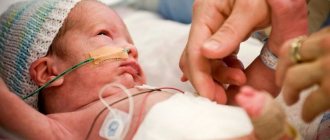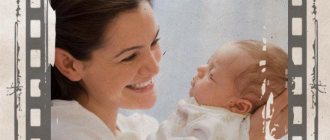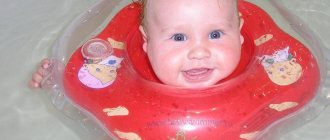How to develop a newborn baby - the beginning
The neonatal period is considered to be the stage from birth to one month. This is a period of adaptation. The baby adapts to life in the external environment, and the parents adapt to the fact that their lives have turned 180 degrees. At this time, the baby’s development is actively underway, both physical and psycho-emotional. To know how to competently develop a newborn baby up to 1 month, you should proceed from his natural abilities, which any healthy baby has.
It would also not be amiss to say that throughout the first year, and especially in the first month, the harmonious development of a newborn will directly depend on his physical condition. In other words, from his weight gain. And this can be achieved if breastfeeding is properly organized and a clear daily routine for the newborn is established by month in the period from 0 to 3.
The regime is especially needed for those who have twins. We have already written a lot about “regime moments” in relation to both one child and twins.
Let's say it again: if the diet, sleep and wakefulness are adjusted, it will be much easier for the baby to develop.
How to develop a newborn baby up to 1 month - unconditioned reflexes
It is worth noting that a newborn human child is perhaps the most defenseless among the cubs of all other animals. However, almost from birth, i.e. even in the first month, he already has unique qualities: receptivity to learning and the ability to comprehend the world, as well as accumulate his own life experience. This is what contributes to the development of intelligence and thinking.
A baby has a number of unconditioned reflexes, thanks to which it harmoniously adapts to life outside the womb. You need to know these reflexes so as not to think that the baby is completely helpless, and that developing a newborn baby up to 1 month is something out of science fiction.
- Sucking and swallowing reflexes. They are connected with the main need of the child - nutrition. They are expressed in the fact that if a baby puts a pacifier or a finger in his mouth, he will tightly clasp it with his lips.
- Search reflex. If you touch the nipple to the baby's skin near the corner of the mouth, he will turn his head in this direction and open his mouth slightly, and even try to reach it.
Emotional development
The main activity of the infant period is emotional communication with the mother (or with the adult who replaces her). All of his subsequent development (including mental development) depends on how much attachment is formed during this period and how much the child is “saturated” with love. This is why children from orphanages, surrounded by a “teaching staff” but deprived of sufficient attention and human warmth, lag behind their peers in mental development. Not because there is a lack of a “developmental program”, but because any development of a baby is based on only one thing - satisfying his needs for emotional communication.
Nowadays there is a threatening fashion for “early development”, when children are “taken to clubs” almost from birth so that they can be “properly developed” there. What does the baby get from such “drivings”? He finds himself in an unfamiliar environment, in artificially created conditions (when his task is to understand the natural course of home life and the world around him), and most importantly, children are very sensitive to their mother’s emotions.
How does a mother feel when she takes her baby to classes (even if it’s not reading for babies, but the most harmless games)? Mom first of all feels that she must get a RESULT. And instead of fully accepting her baby, she begins to experience emotions about “how developed her child is compared to others.” And it is this vibration that the child feels best: is he “good”, is he “smart”? And when a child just needs to be enjoyed, mothers enter him into the achievement assessment system (well, what kind of achievements does a baby have?!).
And the neighbor is already sitting! Already crawling! Already walking! Swims from birth! Tempered! By the age of one he knows all the letters! And mine... And this affects the baby most of all. Because infancy is the period when the life position is consolidated, which ideally should be “there is good in this world, I am loved and I love everyone.” But it turns out “they love me depending on” (the mother is happy when the child satisfies her ambitions, and is upset when he looks “not so smart” compared to his peers).
So, the first harm of “early development” with a passion for “developmental methods” and “going to circles” with the baby is that the mother loses emotional calm, begins to compare her child, and most importantly, projects her emotions on him in connection with this.
Development of a newborn baby in the first month - sensory organs
Vision. A baby's vision is not perfect. During the first time after birth, the baby does not know how to focus his gaze on a stationary object. Although already in the second week you can notice that he sometimes just lies with his eyes open. And here it’s realistic to think about how to develop a newborn child in the first month, and more specifically, teach him to focus on any subject.
It will be very difficult for the baby at first, but he will definitely cope, such is our nature. In the first month of his life, you can hang a bright toy in front of the baby’s face at a distance of 50 cm, and slowly move it horizontally in the newborn’s field of vision, either moving it away or bringing it closer to him. As a result of this exercise, in ten days he will begin to follow her with his eyes. Closer to the third week, you can sometimes stop the toy. This way the child will gradually learn to focus on it.
Hearing. The baby begins to respond to external sounds within ten days. So, if they constantly talk to him, then at two weeks of age, he may become silent when he hears his mother’s voice, or stop eating if the TV is turned on. The question of how to develop a newborn child is also relevant here.
Using a rattle will help a lot in the first month. It should be moved at different distances from the baby. So he will gradually begin to listen to where it is ringing. And if she is also in the baby’s field of vision, then he will begin not only to react to the sound, but also to follow her with his eyes. This is a very good skill - the interaction of hearing and vision.
Spending time with a baby aged 1-2 years
At the age of 1-2 years, the best play partner is the mother. Of course, a child will also be interested in the company of peers, but children develop precisely in the process of joint activities with an adult. What can you do with your child?
- Let's blow soap bubbles
. Usually all kids love to watch multi-colored soap bubbles fly and watch the “magic” of water turning into multi-colored iridescent bubbles. They will be interested in where so many bursting balloons come from, and the child will definitely want to try to blow a soap bubble himself. This activity can drag on until the solution in the bottle runs out.
- Artistic creativity. A one-year-old baby will be happy to paint with finger paints; at 2 years old, a child can already cope with liquid gouache, watercolors, pencils and felt-tip pens. It makes no sense for mom to actively participate in the drawing process: let the child study the properties of paints himself, mix colors and make his own discoveries. In this process, an adult is only required to correctly organize the artist’s “workplace” and slightly direct his actions.
Creative activities for children from 1 year old - finger painting
- Modeling. Offer your baby play dough or regular soft plasticine. You can show your baby how to roll a ball, a sausage, or how to make a flat cake. You should not demand specific results or teach your child to sculpt specific shapes: children are always interested in studying the properties of the material themselves. The advantage of this activity is the development of motor skills.
Making from play dough
- Reading books. Children 1-2 years old are not yet able to perceive long prose and grasp the plot thread. No matter how much we love fairy tales, 1-2 years is the age of poems and rhymes. Short poems on topics that are clear and familiar to the child will be just right. In this case, parents do not have to “reinvent the wheel” and give preference to the classics of children's literature. Also, children really love special musical children's books.
- Role-playing games. At about 1.5 years old, children develop an interest in role-playing games. In such a game, the child imitates an adult, performing the actions that he himself observes every day. The most popular stories for kids are feeding a doll, swaddling it, rolling it in a stroller, putting it to bed. True, many manipulations are still inaccessible to the baby, so it cannot be done without the help of the mother. The older the child, the more “advanced” the plots of his games become.
- Active games. Not a single day with your child should go without them. Why don’t you sit at the table all the time with brushes, plasticine and books?! You definitely need to run and jump and warm up. For example, you can entertain your child by playing catch. If a child does not yet know how not only to run, but also to walk confidently, you can roll a ball on the floor or jump on a fitball.
- We play with toys. It is not enough to fill the entire nursery with different toys. A child can only master them with an adult, so moms and dads definitely need to get involved in such games. For children 1-2 years old, cubes, pyramids, musical instruments, frames with inserts, and construction sets with large parts are ideal.
Toys for a child 1-2 years old
- Air balloons. Children love to play with balloons. You can draw on the balloon, you can inflate it and let it go without tying it - it will whistle very cheerfully and quickly as it deflates. The child will be surprised and interested in how such a small piece of rubber can be used to make a light and large ball. (From personal experience: a small inflated ball was stuffed under a boy’s T-shirt (like a big tummy). His joyful surprise knew no bounds. For about 10 minutes he ran around with the happy face of the owner of a miracle under his T-shirt! https://club-mam.com/parenting/chem -zanyat-rebyenka-v-1-2-goda.html)
What to do with a child
Development of a newborn baby up to a month - body control
The movements of a newborn up to a month are very chaotic. And the first thing that begins to happen is that the neck muscles gradually become stronger. This can be encouraged.
In order for the baby to begin to slowly hold his head up, he should be placed on his stomach for a couple of minutes from the very first days (upon arrival from the hospital). It is most convenient to do this while swaddling. A prerequisite is that the surface is hard. Thanks to the hard surface, the baby's muscles will begin to tense.
If a baby is laid out on his tummy undressed for up to a month, he will take air baths several times a day - these are the first elements of hardening.
Thanks to such exercises, the development of a newborn child will proceed at a rapid pace, and the baby himself will quickly get stronger. And by the end of the first month, he will be able to lie on his stomach and hold his head on his own for a few seconds.
What to do with your baby outside?
We looked at options for keeping a 1 year old child occupied at home. But what about the street, because sometimes you also want to exchange a word with other mothers.
Interesting articles: 15 ideas for keeping your child busy outside 12 games in… puddles Playing with your child in the sandbox How to make kinetic sand yourself 19 educational games with kinetic sand
First of all, the most optimal and breathtaking object will be an ordinary sandbox , which is located in almost all children's playgrounds. For long games, don’t forget to take the standard set in the form of a bucket, scoop and molds.
There are also interesting activities during the winter. Build a snowman or paint on the snow with colored paints . In the spring, take a stick and start measuring the depth of the puddles . In addition, you can launch boats or other small rubber toys to float.
In conclusion, it is worth noting that there are quite a lot of ways to keep a 1 year old child occupied. The baby can perform some of them absolutely independently, while other options require parental supervision. In any case, it is worth changing and alternating activities, because children at this age are very restless, and they quickly get bored with all the games.
To make the process more efficient, it is recommended to divide your child’s toys into several parts and change them from time to time. He does not yet remember all his acquisitions, thus, after a while he forgets about them, and when you give him old and new things, he happily gets carried away with them, as if he had just acquired them.
How to develop a newborn baby - preparation for communication
As we found out above, vision and hearing in newborn babies can be developed literally from the first days, and this also applies to communication.
It has long been noted that newborns who were talked to a lot in the first month will, by one month, look perfectly into the eyes of an adult when they are addressed. This is a very important achievement.
If you want this to happen, then the question of how to develop a newborn child in the direction of communication is easily resolved. You need to talk a lot with the baby. Almost all the time he is awake. At first, this communication will be one-on-one communication, but gradually, by a month or a little later, the baby will begin to respond precisely to the voice of the one who is caring for him, smiling at familiar faces, and then progressively. And it is possible to lay the foundation of communication from the first days of life, i.e. up to 1 month.
At the very end we suggest watching the video. In it, the doctor, without any antics and chatter “but what kind of baby-house-husband I have,” etc.. and fashionable “zakos”, talks about a newborn baby in the first month of life. Addresses issues of sleep, care, development, feeding and stool. A lot at once and to the point. Be warned, the video is long.
Coordination of movements (movement in space)
The more often you change your baby's field of vision, the faster he develops the coordination and balance he needs to sit, crawl, and walk.
- Carry the baby in your arms, holding him either facing you or with his back to you.
- Turn the baby in different directions, carefully supporting the head.
- Do not limit your baby’s stay in the apartment to a crib and changing table. After first making sure that it is safe for the baby, place it on a sofa, armchair, etc.
By the end of the first month, your baby will make a significant leap in development and in response to your love and care, you will very soon receive your first wonderful smile, addressed specifically to you. I wish you success in the development of your children!









